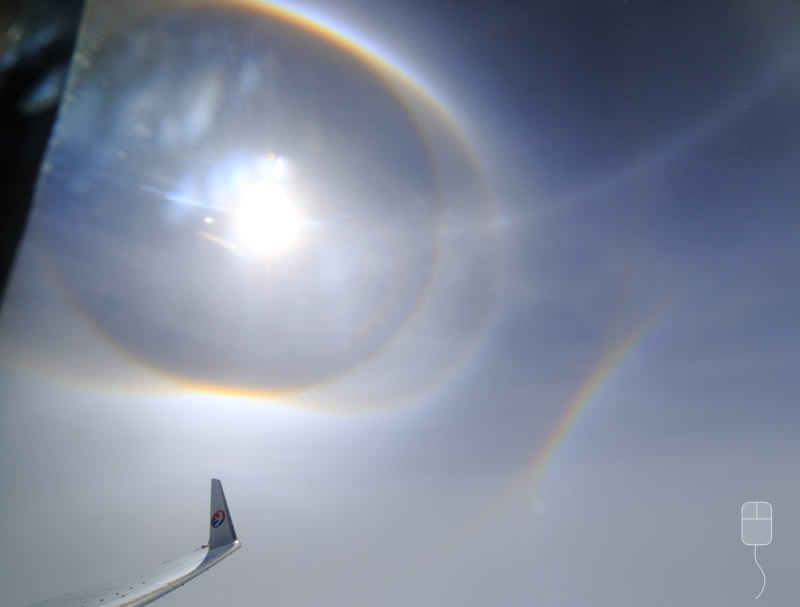 |
 |
| Another image showing the lower sunvex Parry arc just above the aircraft's winglet. Mouse over for a view where the halos are enhanced by levels shift and unsharp masking. This is more aesthetic but less effective than colour subtraction. On this image the latter shows the other Parry arcs and the upper and lower Wegener arcs. Note the parhelion. It was absent in the top image. Crystal populations change quickly at 500 mph! |

| Remarkable Halos, China A magnificent halo display in high and cold cirrus haze. Imaged over NE Yunnan Province by JI Yun (计云) on 4th May 2014. The sun was about 42° high. There are many rare halos. Mouse over the image to see a labelled and enhanced version. Enhancement was by colour subtraction. It highlights coloured halos. Note the upper Wegener arc from horizontal column crystals and its more rare continuation below the sun. Parry arcs are rare. High sun Parry arcs more so. There are three in this image - One above the sun and reaching towards the parhelic circle and two below it. Parry oriented crystals generate helic arcs from external reflections from their side faces. They are exceeding rare unless from the somewhat artificially generated crystals of ski slopes. Here there is a possible faint trace of one in wholly natural high cirrus. Images ©JI Yun (计云), shown with permission |
| Note the lower sunvex Parry arc - a rarity indeed. Its ray path is 5,7. Rays pass through the two lower inclined side faces. |
A Parry oriented column crystal. The long axis is horizontal and the upper and lower prism side faces are horizontal. Unlikely but it happens! |
 |
|
|
|
|

| About - Submit | Optics Picture of the Day | Galleries | Previous | Next | Today |
| A singly oriented column. Unlike Parry crystals, this much more common orientation has the crystal taking all rotational positions about the long axis. Individual crystals do not necessarily 'spin'. |
| Below: An all sky zenith centred ray tracing of the display to better show the Wegener arc. The Wegener is tangent to the top of the 22° halo and curves over the sky to cross the parhelic circle directly opposite the sun (the anthelic point). It continues below the parhelic circle to become tangent to the 22° halo again - this time below the sun. |
| A HaloSim ray tracing computation of the display. The projection matches the camera angle. The simulation is for a single wavelength of green light and normally coloured halos like the infralateral arc therefore appear narrow. The simulation used a mixture of randomly oriented crystals (22 and 46° halos), singly oriented columns (circumscribed halo, infralateral arc and Wegener arc) plus a few Parry oriented columns. |